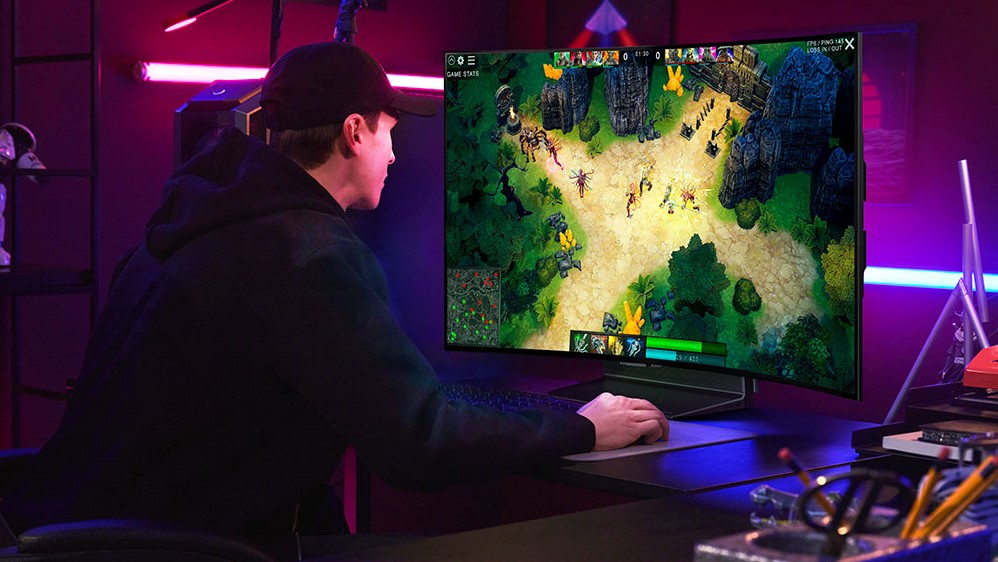I tried LG’s bendable monitor, and it’s everything Corsair didn’t do
The LG OLED Flex is bendable done right

Let’s be clear: the very first real-world implementation of a new tech is never perfect. After all, that’s when limitations, flaws, and shortcomings are often uncovered, when you expose it to actual users and use cases. And, it’s no different with bendable monitors.
So, one can easily forgive the Corsair Xeneon Flex 45WQHD240 OLED for its limitations. Some things were harder to look past than others, particularly in the way its bending mechanism works and how it’s operated. But, especially since its OLED panel is terrific to begin with, it’s an impressive first attempt nonetheless and without a doubt one of the best gaming displays I’ve ever tested.
But then you come across something like the 3,840 x 2,160 LG OLED Flex, which was released around the same time, that absolutely blows everything out of the water, and you start to wonder if Corsair should have taken a bit more time on the drawing board.
To be fair, LG has some advantage over Corsair when it comes to displays, being a top manufacturer of many of the best TVs on the market. But, it’s also worth noting that the bending implementation on this monitor-cum-smart TV – which I think is lightyears ahead – is something that should have maybe been obvious to anyone designing a bendable or flexible display.
At least, I like to think that if I were tasked to create a bendable PC monitor, I wouldn’t have done it the way Corsair did.
Its auto bending is a flex
The current Corsair Xeneon Flex is, I’m sorry to say, awkward to operate. I’m talking specifically about the bending mechanism here. To bend or flatten this monitor, you would, first of all, need both hands. It’s also a two-step process as you’ll need to pull out the handles on both sides to get a good, solid grip.
Bending this monitor is also a little daunting, at least in the beginning. The creaks and clunking noise it makes whenever you adjust its curvature doesn’t help either.
The LG OLED Flex eliminates all that so you need not suffer an angina every time you need to bend or unbend the monitor. It ingeniously automates the process, which makes it much easier, more convenient, and certainly much more elegant.
The OLED panel goes from completely flat to curved within seconds and with just a press of a button on the remote from you — that’s considerably less effort than getting up, gripping handles on either side of the screen, making sure that you’ve got a bit of leverage, and pushing or pulling depending on how you want the monitor. Literally all you need to do here is press the 'Curvature' button on the remote to either cycle through three curvature presets, which you can set, or press the down button to “fine-tune” the curvature.
LG aptly calls this “auto bending,” and the degree of elevation it adds to the curving mechanism over what’s on the Corsair is an absolute flex. And while you do still hear some noise here, it’s more the whirring sound of a machine rather than the mini stroke-inducing clunk of a thin sheet of plastic and metal.
Another bit that I appreciate here is that at default, the monitor automatically returns to a flat position when turned off and reverts back to its last curvature setting when turned on again. Now, there isn’t a lot of research behind the long-term effects of regularly bending such panels, but many suspect that bendy displays in their early iterations are more likely prone to breakage or issues. The fact that this monitor automatically goes back to its natural flat position is giving me a sense of longevity.

The feature set low key slaps
While the LG OLED Flex’s auto bending feature is more than enough to convince early adopters of bendable monitors, the manufacturer doesn’t stop there.
LG manages, first of all, to squeeze in height and tilt adjustability, offering users some good ergonomics. If that’s confusing to you — many monitors offer much more than that — that’s just in comparison to Corsair’s offering, which only gives you some tilt.
But wait, there’s more! LG fitted this with a built-in gaming mic that gives the monitor echo-canceling abilities, 40W speakers with Dolby Atmos support, smart assistant support (it works with Google Assistant, Alexa, Apple Airplay2 and HomeKit), and RGB lighting that can sync to the audio from the speakers or the video being displayed onscreen.
A marquee feature here though is the smart TV functionality, which may be uncommon to PC displays (though you’ll find the likes of the Samsung M8 touting the same feature) but isn’t surprising given that LG is also pushing this as a TV.
I’ve yet to test all these features, but I have to say that there’s already a lot to unpack here, and while I’d rather go for something more minimalist, it’s not hard to imagine that many of these features will prove useful to its users.
That price tag has me shook
Of course, you ain’t going home with one without a catch. To get the LG OLED Flex, you do have to shell out quite a bit of money — $2,999 / £2,999 (about AU$4,500), to be exact.
That’s certainly more than what most people would pay for a gaming monitor, and a hefty $1,000 / £1,000 more than the Corsair Xeneon Flex, which also has the advantage of being bigger and faster with its 45-inch size and 240Hz refresh rate. Even if you look at it from an OLED TV angle – LG is, after all, marketing it as a gaming TV as well – it’s still pretty pricey.
Is it worth it? Considering it's a gaming PC monitor and smart TV in one, it could be to the right users. Even my notoriously cheap friend says that he would rather pay a little more for the LG OLED Flex so long as he’s getting that elegant bending implementation.
I don’t necessarily feel the same way, and I still haven’t finished putting it through its paces (although I did spent considerable time changing its curvature just for fun). But I have to admit, this bendable monitor is pretty darn tempting.
If the LG OLED Flex is out of your budget, our list of the best monitors should have more affordable options for you.
Get daily insight, inspiration and deals in your inbox
Sign up for breaking news, reviews, opinion, top tech deals, and more.

Michelle Rae Uy is the former Computing Reviews and Buying Guides Editor at TechRadar. She's a Los Angeles-based tech, travel and lifestyle writer covering a wide range of topics, from computing to the latest in green commutes to the best hiking trails. She's an ambivert who enjoys communing with nature and traveling for months at a time just as much as watching movies and playing sim games at home. That also means that she has a lot more avenues to explore in terms of understanding how tech can improve the different aspects of our lives.